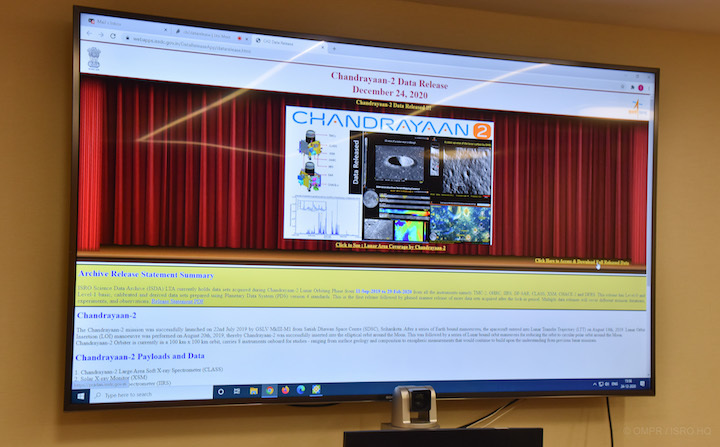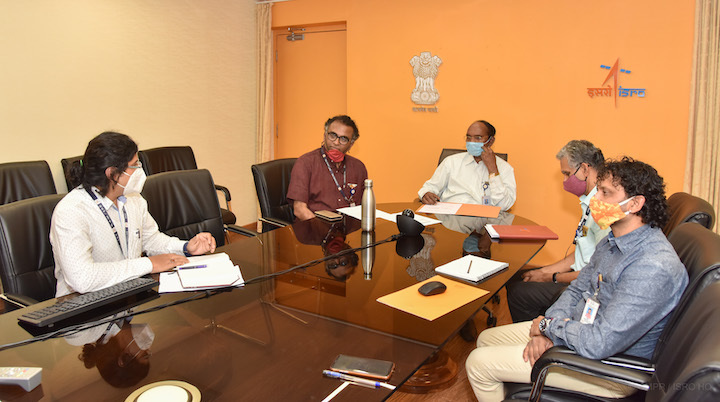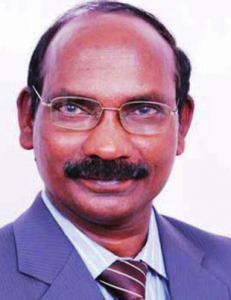25.12.2020
India’s second mission to the Moon, Chandrayaan-2 was launched on 22nd July 2019 from Satish Dhawan Space Center, Sriharikota. The Orbiter which was injected into a lunar orbit on 2nd Sept 2019, carries 8 experiments to address many open questions on lunar science. All experiments have been performing well and the data received, suggests excellent capability to deliver on the pre-launch promises. In the period since launch payload teams tuned onboard systems for optimal instrument configurations, derived essential in-flight calibration data, revised / updated data processing steps / software and have started to publish early results. Today, the first set of data are being released for all users. The public release data archived at the Indian Space Science Data Center in Bylalu, near Bengaluru is prepared in the standard, globally followed Planetary Data System 4 (PDS4) format for public release.

Science payloads and its unique capabilities:
|
|
Terrain Mapping Camera – 2 (TMC-2) |
High resolution topographic maps and Digital Elevation Models (DEM) of the lunar surface. |
|
|
Orbiter High Resolution Camera (OHRC) |
Highest resolution optical images ever (~30 cm) from a lunar orbiter platform. |
|
|
Chandrayaan-2 Large Area Soft X-ray Spectrometer (CLASS) |
Highest resolution surface composition study of Moon using X rays – generation of global elemental maps. Monthly studies of geotail at the Moon – high time resolution particle spectrum and flux mapping |
|
|
Solar X-ray Monitor (XSM) |
Highest time cadence and resolution solar flare spectrum for supporting CLASS and for independent studies of the solar corona. |
|
|
Imaging Infra-Red Spectrometer (IIRS) |
Mapping minerals in 0.8 to 5.0 micron with a focus on extracting clear signature of surface presence of hydroxyl and/ or water. |
|
|
Dual frequency Synthetic Aperture Radar (DFSAR) |
First full polarimetric measurements of permanently shadowed regions. First L-band observation of Moon and along with S-band, provides better identification of sub-surface water. |
|
|
Chandra’s Atmospheric Composition Explorer – 2 (CHACE-2) |
Study of neutral species in the exosphere and its spatial and temporal variations. |
|
|
Dual Frequency Radio Science Experiment (DFRS) |
Lunar charged and neutral environment studies using the radio occultation technique. |
Indian Space Science Data Center (ISSDC) is the nodal center of planetary data archive for planetary missions of ISRO. The Chandrayaan-2 data are required to be in Planetary Data Sysytem-4 (PDS4) standard and required to be peer reviewed scientifically and technically before acceptance as PDS archives and declared ready for sharing with global scientific community and general public. This activity has been completed and hence the first set of data from the Chandrayaan-2 mission are now being released for wider public use through the PRADAN portal hosted by ISSDC. Users may also visit https://www.issdc.gov.in for more information about mission.
ISRO Science Data Archive (ISDA) currently holds data sets acquired by Chandrayaan-2 payloads from Sep-2019 to Feb-2020 from seven instruments. Data sets from IIRS payload will be added to this shortly. This release has Level-0 and Level-1 basic data sets prepared using Planetary Data System (PDS) version 4 standards.

Quelle: ISRO
----
Update: 27.12.2020
.
‘All experiments performing well’: ISRO releases Chandrayaan-2 orbiter data
Bengaluru: The Indian Space Research Organisation on Thursday said it has released the first set of data from the country's second mission to the Moon, the Chandrayaan-2, for the general public.
Chandrayaan-2 was launched on July 22, 2019 from the Satish Dhawan Space Centre at Sriharikota in Andhra Pradesh. The Orbiter which was injected into a lunar orbit on September 2, 2019, carries eight experiments to address many open questions on lunar science.
"All experiments have been performing well and the data received suggests excellent capability to deliver on the pre-launch promises," ISRO said.
In the period since the launch, payload teams tuned on-board systems for optimal instrument configurations, derived essential in-flight calibration data, revised / updated data processing steps / software and have started to publish early results, it said.
On Thursday the first set of data was being released for all users, the ISRO further said.
The public release data archived at the Indian Space Science Data Centre in Bylalu, near Bengaluru is prepared in the standard, globally followed Planetary Data System 4 (PDS4) format for public release, it added.
Quelle: FreePress
+++
India’s space programme built on spectacular failures: ISRO Chairman Sivan

Chennai: Indian Space Reserarch Organisation (ISRO) Chairman K Sivan today said every failures would provide valuable lesson and the India’s space program has been built on spectacular failures as it resulted in improvements in the system.
Delivering the 16th Convocation address at the SRM University at suburban Kattankulathur here, he exhorted the students to take calculated risks to safeguard from absolute failure.
“The most important thing is to take calculated risks. When you take calculated risks, you safeguard yourself from absolute failure. You may fail, but each failure will provide valuable lesson,” he said.
“I can say with great confidence that India’s space program has been built on spectacular failures. Each failure has resulted in improvements in our system,” Sivan, who is also the Secretary, Department of Space, said.
He said the second important thing is innovation. “Innovation is not just having a bright idea on paper. Innovation is how you implement that idea. Innovation comes with a high risk of failure. You may be called crazy, and the initial outcomes of innovation could be imperfect.”
“I need not tell you, how many times Edison failed to invent light bulb. You all must realize that if you are not failing then you are not trying hard,” he said.
Observing that Innovation today has become a strategy to remain relevant and competitiv, the ISRO Chairman said innovation has emerged as the biggest survival strategy.
Pointing out that India aspires to be a Nation with sustainable, equitable and inclusive growth, Sivan said the first focus area that need to be prioritized was high tech manufacturing.
More efforts should be made towards private and public sector partnerships and joint ventures to benefit from investments and technology transfer and increase skills among workers to make them more employable, he noted.
“Towards this Government has already announced space sector reforms for greater participation of non-governmental entities in space activities,” he said, adding, ISRO’s next PSLV launch will have satellites from start-up agencies as first product of these reforms.
The second priority is to train and attract world-class talent. India’s growing economy, focus on technology-intensive sectors and the changing nature of employment will drive demand for high-quality talent, Dr sivan said.
The ‘Digital India’ initiative is another key area to leverage and ISRO has already initiated reforms to make its digital assets available easily to industry as well as start-ups for making innovative applications in navigation, earth observation as well as disaster management.
As India continues to focus on economic growth, it needs to ensure that environmental damage is limited by adopting green technologies. ISRO has done the technology transfer of its space grade lithium-ion batteries to industry.
This technology is useful for mass adoption of electrical vehicles without remaining perpetually dependent on foreign sources, he said.
Even in rocket propulsion, ISRO is developing green propulsion for its human spaceflight mission. In future, all the propulsive stages may adopts green propulsion, sivan said.
Sivan concluded his address by telling the students “shoot for the sky. Even if you miss, you’ll land among the stars. Spread joy. Chase your wildest dreams. And now go, and make interesting mistakes, make amazing mistakes, make glorious and fantastic mistakes and make the world a more interesting place.”
Quelle: News Today

